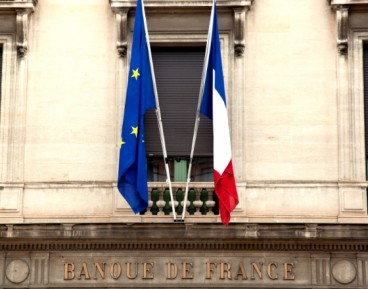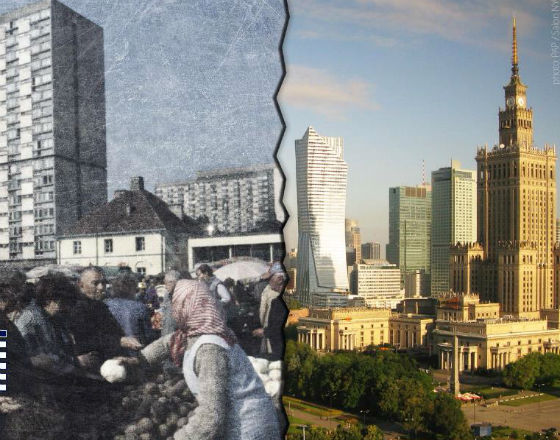Energy and climate transitions: current and future challenges
Category: Macroeconomics

Warsaw yesterday and today (pics.: PAP/ CC By Sabon NYC)
Indeed, even speaking of “transition economies” as a distinct grouping of countries, with similar obstacles, makes little sense in 2014; in reality, much of the pain of transition has passed in many of the countries that started the journey in 1989, with countries such as the Czech Republic and Poland facing the same economic difficulties that plague the UK or France.
The reality from the vantage point of 25 years on is that the countries in CEE have diverged both economically and politically since the heady days of 1989.
Unfortunately, the sprint to catch up to western Europe has also led to a race to the bottom in terms of regulation and economic openness. In order for the CEE countries to succeed like they did in the first 15 years after the transition away from communism, and to break with the moribund example of troubled Western Europe, they need to recapture that same spirit of adventure, experimentation, and, in reality, anti-communism. That means bolder efforts at deregulation and innovative approaches to taxation.
In many respects, the events of this past year have clarified that the transition process itself proceeded at different paces across the region, with consequences that are now only being felt. Ukraine, for example, appeared to be on par with other countries in transition, perhaps a bit of laggard and with some political issues, but the Maidan revolution and Russian invasion exposed just how broken the country really was – and, unfortunately, how little it had transitioned. Similarly, Russia was seen to be a country that fought hard through the 1990s to transform, and was on a stable (if autocratic) footing. The annexation of Crimea and proxy war in the Donbas, coupled with Vladimir Putin’s rhetoric towards the West and the coming collapse of the Russian economy, exposed Russia’s transformation as less of a move towards Europe and more of a move towards the past.
Given recent events, it is time to take stock of the whole transformation process over the past quarter-century. While a lot has gone right throughout the region as a whole – more than could have ever been expected from the harsh days of the early 1980s – there is also a lot that could have been done much, much better. The key question is if it is too late to correct the mistakes of transition and resume the momentum of the early 1990s, or if the next 25 years are going to be a long, slow slide into stagnation.
The key question is if it is too late to correct the mistakes of transition and resume the momentum of the early 1990s, or if the next 25 years are going to be a long, slow slide into stagnation.
As just mentioned, the success of transition in most of the countries in CEE and a few countries in the former Soviet Union (FSU) was nothing short of miraculous. Apart from Yugoslavia, which broke apart in a frenzy of bloodlust and whose successor states are still handicapped by this legacy, the political transition in the CEE countries was accomplished without civil war and, in the case of the Czech and Slovak Republics, in an almost routine manner. Even Russia’s early transition, as Anders Aslund likes to point out, occurred peacefully, with the Soviet republics going their own way.
Economically, though, is where the real miracle occurred. In the so-called “shock therapy” countries, those who went the fastest and the furthest, the shedding of the planned economy led to increases in GDP, consumption, and goods on the shelves. For the best-performing countries, once the transformational recession (in Janos Kornai’s memorable phrase) was completed, an average annual growth of 7.2% buoyed these countries above their initial GDP per capita levels by the late 1990s.
Oft-forgotten Slovakia can be seen as an example of this success. Going from the junior partner in Czechoslovakia to an independent nation in 1993, the Slovak Republic got a later start on the transformation process than the other CEE countries due to the erratic leadership of Vladimir Meciar until 1998. But after shedding Mr. Meciar, Slovakia saw impressive economic gains, mainly due to innovative policies pursued by the centre-right government of Mikuláš Dzurinda. For instance, Slovakia was the first to institute a flat tax, setting off a wave of fiscal experimentation in eastern Europe that still seems crazy to stodgy west Europeans. Slovakia was also an early entrant to the eurozone, on the back of its fiscal and monetary prudence in the late 1990s and early 2000s, and saw solid and sustainable GDP growth as part of convergence with western Europe.
The transition experience itself was not a smooth process. In the first instance, the transformational recession lasted longer than most economists or policymakers expected. Using Charles Wyplosz’s numbers from above, even the best-performers on average waited 3.6 years to see growth again (with Poland moving slightly faster than this average), while the worst-performers took nearly six years of contraction before growth returned. It turned out that the economy was a complex system of interrelations, and it would take some time for the millions of individual pieces of the system to reorient correctly. The institutions necessary for a market economy needed stability and nurturing to come out of hiding.
Indeed, it has been in institutional development where some difficulties still exist, as not every country went as far as Estonia or Poland in laying the basis for institutional growth. This is not the same critique that Joseph Stiglitz and Grzegorz Kołodko were spouting around 2000, that “institutions were neglected” in transition. Given that transition was all about institutions, changing from those that facilitated central planning to those that facilitated a market meant that if you didn’t change your institutions, you didn’t transition. And as I proved in my book on institutions in transition, those countries that did actually neglect institutions (Belarus, Tajikistan, Uzbekistan, for starters) were the ones that had the poorest economic outcomes.
With each successive crisis and move towards Europe, the economic institutions in the East retreated from their impressive changes and began to converge with international worst, rather than best, practices
The problem was thus not that institutions were neglected, it was that new market friendly economic institutions started off brilliantly in a few select countries and then pulled back as regular politics started to encroach, while in others (mainly in the former Soviet Union), institutions and stabilisation weren’t even tried. And with each successive crisis and move towards Europe, the economic institutions in the East retreated from their impressive changes and began to converge with international worst, rather than best, practices. The chart below illustrates this fact, taken from an article I wrote in 2013 looking at institutional change in the entire transition realm during the global financial crisis. Focusing only on property rights, the most important foundation of a market economy (as well as an institution that had to be built largely from scratch), we can see that the transition economies as a whole hit their high-water mark in property rights in January 2006. From there, it was a steep decline throughout the global financial crisis, with countries such as Slovenia and Hungary enacting policies that threatened the sanctity of property.
Even in star performers such as Poland, parts of the institutional make-up of the country have lagged behind. For example, Poland continues to see low levels of investment in its economy – it should be much higher in the World Bank’s Doing Business rankings than it is. In fact, most of the Visegrad Four countries should have better business environments than they do, a reality that the Baltic countries have seized upon in cutting regulations and simplifying life for entrepreneurs. Avoiding the “middle income trap” has become the new mantra for many of the transition economies in the CEE region, a recognition that simple fundamentals like the business environment are required for continued growth.
On an even more basic level, some countries faltered quickly in both policies and institutions. For example, after being the fastest out of the gate, thanks mainly to the years of “goulash communism” that allowed for some semblance of private enterprise, Hungary’s position at the end of 25 years of transition is somewhat tenuous. With high taxes, nationalist rhetoric that questions the value of liberal democracy, and monetary policy inspired by the Marx Brothers, Viktor Orban’s Hungary has taken dangerous steps in the direction of authoritarian politics. Similarly, Slovenia, the one bit of the rump Yugoslavia to get off relatively easily from the wars of the 1990s, has been hit hard by the global financial and Eurozone crises, a consequence of its still-state-run banking system and poor economic policies.
Ironically, one of the most important factors in the transition has also, of late, morphed into one of the greatest obstacles, responsible for some of the stagnation seen in the region since the global financial crisis. Unlike the former Soviet Union, which never realistically had a chance of being incorporated into the European Union, the CEE countries were able to focus their sights on EU accession almost immediately. While this gave the countries of the region a concrete goal, one replete with a pre-fabricated legal system and regulatory structure, in recent years the EU has been weighed down by the euro and the Eurozone crisis, and as a result has dragged down the CEE.
Poland’s successes over the past decade have come in spite of Europe, not because of it. One only need look at Poland, whose successes over the past decade have come in spite of Europe, not because of it: not adopting the euro, keeping its own banking regulation, and being (along with Estonia) especially oriented towards the EU Eastern Partnership countries. The target of EU accession was a grand one, but the goal of adopting EU legislation and institutions was perhaps a bar set too low. Perhaps the CEE countries should have aspired, like Slovakia did with the flat tax, to introduce the next important innovation. Instead, even Slovakia abandoned the flat tax in 2013 as part of a move towards European-style austerity (tax increases and no spending cuts).
In sum, it is not enough for CEE countries to rest on their laurels as part of Europe, and outsource growth to Berlin or (heaven forbid) Paris. Instead they should try to recapture a bit of that daring and experimentation that made them growth champions during the early phase of the transition.
Christopher A. Hartwell is President of CASE – Center for Social and Economic Research in Warsaw and Associate Professor at Kozminski University.


